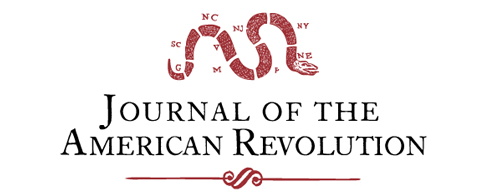Many descriptions of Gen. George Washington’s crucial decision on August 14, 1781, to turn from an attack on the British in New York to a similar attack in Virginia jump directly from his receipt of Adm. Francois Joseph Paul, Comte de Grasse’s July 28 letter describing his intent to take his fleet to Chesapeake Bay to placing the allied armies in motion for Virginia, with no recognition of the huge transportation requirements of that campaign and without mentioning how that move was financed.[1] At the time Washington decided on the Southern campaign, he and Lt. Gen. Jean Baptiste Donatien de Vimeur, Comte de Rochambeau had been planning an attack on the British in New York which entailed only local transportation of their forces. The Continental army planned to use heavy ordnance and supplies primarily from the West Point inventory.[2] French fleet superiority in the area was expected to protect and facilitate movement of men and materiel around the area by water. In contrast, the Yorktown Campaign required transportation of 30 tons of Continental ordnance located at West Point and 490 additional tons located at Philadelphia for 450 and 300 miles, respectively.[3] (The French siege ordnance was located in Rhode Island and would be transported by water directly to Virginia.) In addition, Washington planned to march between 6,000 and 7,000 Continental and French troops to Virginia, facilitating that movement using ships on the Delaware River and Chesapeake Bay. Troops and materiel had to get to Virginia quickly since de Grasse committed to keep his fleet in Chesapeake Bay no later than October 15, which was only sixty-three days after Washington’s receipt of his letter.[4] All shipping and most of the land transportation had to be obtained from private owners who demanded payment in specie since the Continental Dollar was worthless by this date.[5]

A notable exception to the descriptions mentioned above is Charles Rappleye’s biography of Robert Morris which describes events immediately following Washington’s receipt of de Grasse’s letter including his meeting with Morris.[6] The latter, now Continental Superintendent of Finance, had gone from Philadelphia to the army’s camp at Dobbs Ferry, New York, to discuss Washington’s plans for the 1782 campaign and ways to economize in implementing that plan. The Continental Congress asked Richard Peters, a member of the Board of War, to accompany Morris.[7]
This meeting turned out to be of profound significance to the Continental army’s performance in the Yorktown Campaign. The only account of it is contained in a letter written on January 12, 1818, by Peters to Gen. W. H. Harrison. Written thirty-seven years after the events and then abstracted and published ten years later, it contains a few inaccuracies as to places and events but its essential message concerning Morris’s role in the campaign is supported by the record. The relevant portion of Peters’ letter reads:
One morning at the beat of reveille, Mr. Morris and myself, who occupied the same marquee, were roused by a messenger from head quarters, and desired forthwith to repair thither.[8] We were surprised at the circumstance; every thing having been the evening before perfectly tranquil. We were more so on our meeting the general, who, the moment he saw me, with expressions of intemperate passion, (which I will not repeat,) handed to me a letter from the French admiral, who commanded six or seven ships at Rhode Island. . . . The letter informed the general that the writer had received by an express frigate, arrived from the fleet of Comte de Grasse, at sea, orders to join that fleet in the Chesapeake, as the Comte had changed his destination, on information that the bay of New-York was dangerous for his heavy ships, co-operation was offered during the few weeks of his intended stay in those waters, to avoid the West India hurricane season. Secrecy was enjoined, and we went on our way. On returning to breakfast, we found the general as composed, as if nothing extraordinary had happened, and measures concocting for the emergency. I had often admired these conquests over himself. . . .
In the course of the day, I was asked by the general: ‘well, what can you do for us, under the present change of circumstances?’ I answered, ‘please to inform me of the extent of your wants.’—Being, after some time, so informed, generally, I replied: ‘I can do every thing with money; nothing without it; but what can be transported from hence, must be relied on.’[9] I looked impressively on Mr. Morris, who said, ‘I understand you; I must have time to consider and calculate.’
Mr. Morris shortly after told the general that he had no tangible effects; but if anticipations on the credit of his personal engagements would succeed, he could supply the means for transporting the army from New-Jersey to the Chesapeake.[10]
“In a day, or two,” continued Peters, “we left Camp, under injunctions of secrecy, (which we faithfully observed) until the general developed his final objects and measures to Congress.”[11] As a result of the secrecy injunction, no contemporaneous record of the meeting or its decisions was made.
The episode Peters described probably occurred the morning of August 14; later that day Washington asked him what the Board of War could do to support the army, to which Peters asked Washington “the extent of his wants.” Washington had asked Gen. Henry Knox on August 1 to consider the Continental Artillery’s needs for a Southern campaign, so Knox was readily able to provide a general description of those needs including the ordnance and projectiles required from Philadelphia weighing 490 tons.[12] This constituted the heaviest portion of the army’s baggage. The 6,000 to 7,000 men Washington planned to take weighed another 500 tons, so his “general” need was to transport a load, including the ordnance from West Point, of just over 1,000 tons to Virginia.[13] Peters then looked to Morris for a commitment of hard money required to implement the transportation of this load. Morris asked for time to “consider and calculate.”
Morris’s calculations would have considered the need to transport the total of over 1,000 tons, mostly via ships but including waggonage across the portage from Christiana Bridge, Delaware, to Head of Elk, Maryland. As a merchant he knew how to estimate the quantity of registered tons of shipping required to transport this deadweight tonnage of materiel and troops, and hence its cost.[14] Morris probably estimated the cost of just shipping the supplies to Virginia at over £1,200.[15] Whether he included the additional costs due to retention of shipping to move food to the allied armies (which drove the actual cost to nearly £10,000) is not known but he concluded that his personal credit was sufficient to finance the move.[16] Based on this estimate, Morris told Washington that while the government lacked hard money to pay for the move, he would commit his own credit to secure the transportation.[17]
What did he secure? Since it was impractical to haul 520 tons of ordnance and supplies plus the army’s other baggage to Virginia, these had to go via water. Morris secured water transportation on the Delaware River and Chesapeake Bay and land transportation over the portage between them. He guaranteed payment of ship captains and owners for that portion of the trip; using the local deputy quartermasters general, he contracted for thirty-one vessels on the Delaware and fifty-nine on the Chesapeake.[18] Without these, the Continental army and its ordnance would have had to rely on ships supplied by de Grasse’s fleet after they had transported French troops to Virginia.[19] That would have taken much longer than the twelve days from Head of Elk to James River required by the transportation Morris arranged since the draft of the French ships required them to be loaded in the lower Elk River rather than at Head of Elk.[20] These delays would have required a significantly longer transportation period when, due to de Grasse’s deadline, time was of the essence. In June, Morris had begun guaranteeing payment for food for Continental troops and he continued to do so throughout the campaign.[21] These actions could only have been taken by someone with the influence, resources and credibility that Morris possessed.

Early in this move to Virginia, Washington asked Morris to arrange a month’s payment in specie to the Continental troops on the march as an inducement to make it. Morris negotiated with Rochambeau to borrow $20,000 against funds being brought to Virginia by de Grasse, but that turned out to be $6,200 short and Morris was forced to supply that sum from his personal funds or loans from friends.[22]
Collectively, these actions left Morris temporarily without cash or credit.[23] In his own words, “the late movements of the Army have so entirely drained me of money, that I have been obliged to pledge my personal credit very deeply, in a variety of instances, besides borrowing money from my friends; and advancing, to promote the public service, every shilling of my own.”[24] His personal finances subsequently stabilized, and some have even ventured to call his actions self-serving. They ignore that fact that Morris offered his backing for the Continental army’s move when there was no one else to do it and no guarantee that the allies would be successful in the campaign; had they failed, the campaign and the war might have ended in favor of the British, to Morris’ detriment.[25] Judge Peters’ 1818 tribute to him cannot be improved: “Mr. Morris supplied the money or the credit . . . it may truly be said that the financial means furnished by him, were the main-springs of transportation and supplies for the glorious achievement, which effectually secured our independence.”[26]
[1] Henry P. Johnson, The Yorktown Campaign and the Surrender of Cornwallis (New York: Harper and Brothers, 1881), 83-85; Jerome A. Greene, The Guns of Independence (New York: Savas Beatie, 2025), 16-18; Burke Davis, The Campaign that Won America (New York: Dial Press, 1970), 21-23; Thomas Fleming, Beat the Last Drum (New York: St. Martins Press, 1963), 92; Robert Arthur, The End of a Revolution (New York: Vantage Press, 1965), 94-95; H.L. Landers, The Virginia Campaign and the Blockade and Siege of Yorktown 1781 (Washington: GPO, 1931), 151.
[2] Most of the ordnance and projectiles required for a siege of New York was available at West Point as shown by “General Return of Ordnance and Military Stores at the several Places undermentioned agreeable to their several dates,” Miscellaneous Numbered Record 21326, U.S. Revolutionary War Miscellaneous Records (Manuscript File), 1775-1790s, Records Pertaining to Continental Army Staff Departments, Record Group 93, National Archives Publication M859 (MNR). The record for West Point is dated January 1, 1781. Washington also planned to bring a few siege pieces from Philadelphia and to rely on iron furnaces in northern New Jersey that had substantial projectile inventories.
[3] “Stores with the Army coming from Hudson’s River,” GLC02437.10023; “Ordnance & Stores necessary for the intended operations southward, to be provided immediately at Philadelphia by the Commissary General of Military Stores,” GLC02437.09885, Knox Papers, Henry Knox Papers, Gilder Lehrman Institute, New York (Knox Papers). All tonnage figures herein are based on the long ton of 2,240 pounds.
[4] De Grasse’s letter is in Henri Doniol, Histoire de la Participation de la France a l’Etablissement des Etates-Unis d’Amerique (Paris: Alphonse Picard, 1892), 5: 520-522. The October 15 date was extended to November 1, 1781, in Washington’s meeting with de Grasse on September 17.
[5] Farley Grubb, The Continental Dollar: How the American Revolution was Financed with Paper Money (Chicago: University of Chicago Press, 2023), 148.
[6] Charles Rappleye, Robert Morris: Financier of the American Revolution (New York: Simon and Schuster, 2010), 253-256. Robert M. Morris, Robert Morris: Inside the Revolution (Walterville, Oregon: Trine Day LLC, 2021/2022), 260, also describes these events but relies on Benjamin Lossing’s inaccurate account of the Morris-Peters-Washington meeting.
[7] Samuel Breck, Address Delivered Before the Blockley and Merion Agricultural Society on Saturday, September 20th, 1828. On the death of their late President the Hon. Richard Peters (Philadelphia: Lydia R. Bailey, 1828), 11. Charles W. Upham, The Life of Timothy Pickering (Boston: Little. Brown and Company, 1873), 2:54, says that Timothy Pickering accompanied Morris, but Peters’ account is clear that he represented the Continental Congress and the Board of War at this meeting. This is confirmed by Peters’ statement of August 30, 1818, in the Revolutionary War Pension Application of Abel Evans, S41521, and by The Papers of Robert Morris 1781-1784, ed. E. James Ferguson (Pittsburgh: University of Pittsburgh Press, 1973), 1:418.
[8] This must have been on August 14 since Washington’s Diary entry for that day says that was when he received de Grasse’s July 28 letter via Admiral Jacques-Melchior Saint-Laurent, Comte de Barras. The diary does not state what time of day that letter was received but if Washington was incensed about it early in the morning, it must have arrived very early in the day. Rappleye, Robert Morris, 255, says the morning meeting took place on August 15, which seems inconsistent with the diary and Peters’ description.
[9] This probably indicates Peters’ uncertainty about the readiness for shipment of the stores located in Philadelphia, causing him to recommend that any stores available at West Point should be brought on the campaign.
[10] Breck, Address, 11-14.
[11] Ibid. Morris and Peters left camp on August 18 and returned to Philadelphia on August 20. Peters’ subsequent role in preparing Philadelphia ordnance stores for shipment was substantial.
[12] Three days later Knox handed Peters the detailed list of his Philadelphia ordnance requirements, found in “Ordnance & Stores necessary for the intended operations southward,” GLC02437.09885, Knox Papers.
[13] The troop tonnage is estimated assuming a weight of 160 pounds per man including his musket.
[14] For tonnage relationships, see Frederic C. Lane, “Tonnages, Medieval and Modern,” The Economic History Review, New Series, 17, no. 2 (1964), 213-217.
[15] This figure is based on the actual tonnage of ordnance supplies shipped from Head of Elk to James River during this campaign, the actual shipping required, and the going rate of one shilling per ton per day for ten days, scaled up to the 1,000 tons of supplies mentioned in the text. See “A list of the Vessels appropriated to the American Army, loaded with Ordnance & Stores &c &c,” GLC02437.01202, Knox Papers.
[16] Incomplete lists by the local deputy quartermasters general show shipping costs of £7,976 so the total cost of shipping alone exceeded £8,000. Land transportation across the portage added £1,620. See “An Estimate of Vessels taken into Transport Service at the Port of Baltimore for the Expedition against General Cornwallis 1781. By David Poe A.D.Q.M.,” MNR 26675, and “Mr. Yeates Estimate of the hire of vessels &c in the expedition against Cornwallis 1781,” MNR 26673.
[17] One form of this credit was the earliest version of what were later called “Morris notes,” backed by his personal credit, according to Ferguson, Papers of Robert Morris, 2: 120. These notes were used more widely in 1782 as described in Clarence L. Ver Steeg, Robert Morris: Revolutionary Financier (Philadelphia: University of Pennsylvania Press, 1954), 87, 117.
[18] Ferguson, Papers of Robert Morris, 2: 85, 93, 119, 147, 174; William W. Reynolds, “Logistics of Victory: Moving the American Siege Artillery to Yorktown,” Military Collector and Historian 70, no. 4 (Winter 2018): 370, 372.
[19] These were deep sea transports and frigates according to de Grasse. See Correspondence of General Washington and Comte De Grasse 1781 (Washington: Government Printing Office, 1931), 33. These vessels were able to enter the harbor at Annapolis but not the shallow Elk River at Head of Elk.
[20] Reynolds, “Logistics of Victory,” 373. As one example of the logistics challenge, the Continental army took over 22,000 shot and shells on the campaign; those would have had to be moved from Head of Elk to the point that the larger French ships could reach.
[21] Victor L. Johnson, “Robert Morris and the Provisioning of the American Army During the Campaign of 1781,” Pennsylvania History: A Journal of Mid-Atlantic Studies 5, no. 1 (January 1938): 10.
[22] Ferguson, Papers of Robert Morris, 2:172-173, 212, 220, 252, 273.
[23] Ibid., 2:244, 297, 309-310.
[24] Ibid., 2:309.
[25] Grubb, Continental Dollar, 192; Ver Steeg, Robert Morris, 112.
[26] Breck, Address, 14.





Recent Articles
Lt. Elijah Evans of Maryland: Unresolved Promotion in an Extra Continental Regiment
A Journey North: Jefferson, Madison, and the Forging of a Friendship
New Jersey’s Revolutionary Rivalry
Recent Comments
"The Evolution of the..."
This article is a gem. Sparkling. Excellent research. Wide and deep. Thank...
"The Evolution of the..."
A very interesting article, thank you! A more general question, if you...
"The Evolution of the..."
Thoroughly researched and a succinct presentation, especially given the article's breadth.